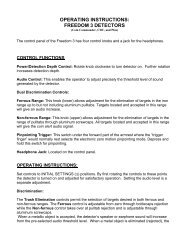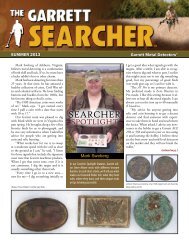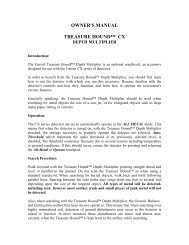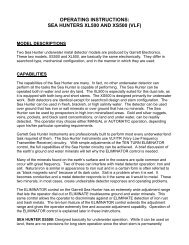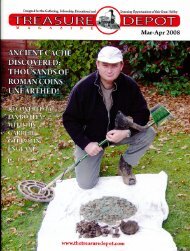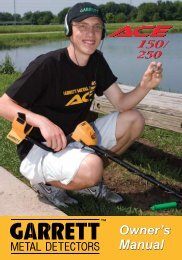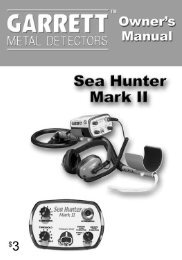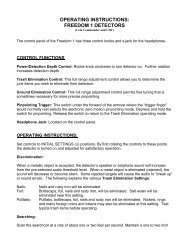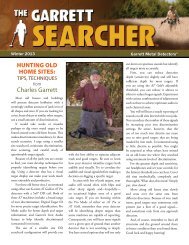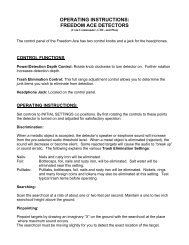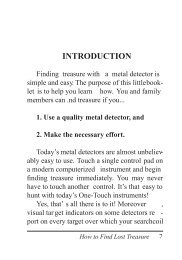operating instructions: scorpion gold stinger - Garrett
operating instructions: scorpion gold stinger - Garrett
operating instructions: scorpion gold stinger - Garrett
Create successful ePaper yourself
Turn your PDF publications into a flip-book with our unique Google optimized e-Paper software.
Nugget Hunting: Using the large searchcoil, manually ground balance the detector slightlypositive in relation to the ground. This condition makes detection of small nuggets easier sincedetectors that adjust slightly negative have a tendency to overlook the smaller nuggets.Hot Rocks: The Scorpion Gold Stinger will instantly identify both types of “hot rocks” in anysearch area. Test for them in the following manner. Simply scan in the All Metal mode. Whenyou locate a suspected hot rock, press the Master Control switch to Motion Discriminate, withthe discrimination control turned fully counterclockwise, pass back over the target. If the targetis a hot rock, it will not respond. If it has sufficient metal content, it will respond as metal. If it isa large <strong>gold</strong> nugget or non-ferrous metal, the audio will sound. Because small nuggets orother metallic targets sometimes produce no response in the Motion mode, it is advisable touse this method only to test suspected hot rocks that respond loudly and positively to All Metalscanning.Searchcoil sizes will differ according to the area being searched. If the search area is in a drywash or among large rocks that restrict the use of a large coil, change to the smaller size.When working in areas that have already been searched, your best option may be to changeto the 5 x 10 Elliptical DD searchcoil. Extremely small nuggets may be missed with the largercoils, but the increased depth and sensitivity will permit you to detect deep nuggets that mayhave been previously missed. Professional nugget hunters know that one nugget of decentsize is better than hundreds of microscopic ones.Alkaline salt is heavily present in some rich nugget hunting areas. Attempts to search suchareas with metal detectors have met with failure over the years because of the difficulty inground balancing. However, by using the DD searchcoils and a relatively low level ofdiscrimination, salt is usually ignored and large nuggets are detected.Never attempt to operate any large searchcoil too close to heavy salt or extremely negativeground minerals. Maintain an <strong>operating</strong> height of approximately three to five inches.OPERATING RECOMMENDATIONSAs you operate and use your <strong>Garrett</strong> detector, you will quickly grow more proficient in its use.It is recommended that you build your own test plot. Bury several items, including a nail, apiece of foil, a pulltab, a bottlecap and several coins at depths of about two to eight inches anda foot apart. Clearly mark the location where each article is buried. Practice scanning thetargets while listening to and studying the detection signals.Remember that newly buried objects, especially coins, will be somewhat more difficult todetect than items that have been buried for some time. This is primarily a metallurgicalphenomenon. Experiment with the various <strong>operating</strong> modes to see how your detectorresponds. Practice trying to pinpoint and locate targets precisely.When scanning, do not hurry. Scan the searchcoil at a speed of about one to two feet persecond. Keep the searchcoil flat and level to the ground. Move it back and forth slowly andsteadily while you walk at a pace that is comfortable. Be methodical. Do not skip any areas.Wear headphones for greater sound perception and concentrate on your scanning.



